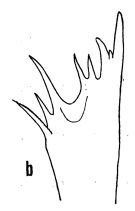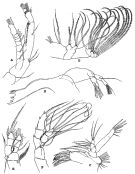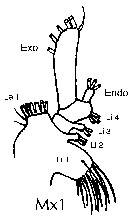|
|
 |
|
Calanoida ( Order ) |
|
|
|
Arietelloidea ( Superfamily ) |
|
|
|
Augaptilidae ( Family ) |
|
|
|
Euaugaptilus ( Genus ) |
|
|
| |
Euaugaptilus elongatus (Sars, 1905) (F,M) | |
| | | | | | | Syn.: | Augaptilus elongatus Sars, 1905 c (p.13, Descr.F); Farran, 1908 b (p.71, Rem.) | | | | Ref.: | | | Sars, 1925 (p.270, figs.F,M); Rose, 1933 a (p.225, figs.F,M); Jespersen, 1934 (p.113); 1940 (p.60); Lysholm & al., 1945 (p.38); Sewell, 1947 (p.197, 198, 200, 201, no 203, figs.F); Brodsky, 1950 (1967) (p.384, Rem.); Vervoort, 1965 (p.134, Rem.); Matthews, 1972 (p.29); Tanaka & Omori, 1974 (p.205, Rem.: 223, figs.F,M); Roe, 1975 (p.361, Rem.); 1984 (p.359); Bradford-Grieve & al., 1999 (p.882, 940, figs.F,M); Vives & Shmeleva, 2007 (p.195, figs.F,M, Rem.) |  issued from : O. Tanaka & M. Omori in Publs Seto Mar. Biol. Lab., 1974, XXI (3/4). [p.206, Fig.6]. Female: a, forehead (lateral); b, last thoracic segment and urosome (lateral left side); c, idem (dorsal); d, rostrum (frontal view); e, A2; f, Mx1; g, Mx2; h, P1; i, P5. Nota: The urosome segments and furca are in the proportional lengths as 45:13:17:23 = 100. Prosome and urosome are in the proportional lengths as 77:23. Male: j, P5. Nota: The urosome segments and furca are in the proportional lengths as 19:15:14:12:14:26 = 100.
|
 issued from : O. Tanaka & M. Omori in Publs Seto Mar. Biol. Lab., 1974, XXI (3/4). [p.198, Fig.1,b]. Female: b, mandibular teeth.
|
 Issued from : G.O. Sars in Résult. Camp. Scient. Prince Albert I, 69, pls.1-127 (1924). [Pl.LXXXIV, figs.1-13]. Female: 1, habitus (dorsal); 2, idem (lateral left side); 3, rostrum; 4, A2; 5, Md; 6, Mx1; 7, Mx2; 8, Mxp; 9, P1; 10, P3; 11, P5. Male: 12, P5; 13, urosome (dorsal).
|
 issued from : R.B.S. Sewell in The John Murray Expedition, 1933-34, Scientific Reports, VIII (1), 1947. [p.204, Fig.52]. With doubt. Female (from Arabian Sea): A, A2; B, Md; C, Mx1; D, Mx2; E, P1; F, P5. Nota: Proportional lengths of the prosome and urosome as 70 to 30. Proportional lengths of the various segments of the body (cephalon to caudal rami) as 408:122:61:46:70:119:43:51:80 = 1000. A1 overreaches the tip of the caudal rami by the last 5 or 6 segments. In A2 the endopod and exopod are approximately equal length; exopod 8-segmented, the 3rd devoid of seta. Md possesses a well-developed palp, the two rami being of approximately equal length; the biting edge is much more oblique than in either nodifrons or indicus, the teeth are arranged in 3 groups, possessing 2, 2, 3 teeth respectively. The 2nd basal segment of Mx1 (on the right side) bears 4 setae (instead of 3 in Farran, 1906). In both the Mx2 and Mxp the distal setae are fringed with large \"buttons\" and in each seta one can trace a gradualtransition from hairs, through small spines to \"buttons\". In P1 the 2nd basal segment bears a retroverted seta near the distal outer angle. In P5 the 2nd basal segment bears an extremely long, delicate seta, the total length of which is about twice the length of the exopod.
|
 issued from : H.S.J. Roe in Bull. British Mus. (Nat. Hist.) Zool., London, 1975, 28 (7). [p.361, Table I). Number of endopodite setae on the Mx1 and Mx2 of E. hyperboreus and E. elongatus. Nota: See remarks in Euaugaptilus hyperboreus.
|
 issued from : J.M. Bradford-Grieve, E.L. Markhaseva & C.E.F. Rocha & B. Abiahy in South Atlantic Zooplankton, Edit. D. Boltovskoy. 1999. Vol.2. Copepoda. [p.1036, Fig. 7.247]. Female: Mx1. Nota: Exopod of Mx1 with 6 setae: outer lobe 1 with 8 setae; inner lobe 4 with 3 setae; Endopod with 3 setae.
|
 issued from : J.B.L. Matthews in Bull. Br. Mus. (Nat. Hist.) Zool., 1972, 24 (1). [p.25, Table 2]. Differences in setation of Mx1, according to previous descriptions.
| | | | | Compl. Ref.: | | | Sewell, 1948 (p.330, 504, 522, 528, 530, 533); C.B. Wilson, 1950 (p.204); Grice, 1963 a (p.496); Grice & Hulsemann, 1965 (p.224); Mazza, 1966 (p.72); Grice & Hulsemann, 1967 (p.18); Roe, 1972 (p.277, tabl.1, tabl.2); Vives, 1982 (p.294); Kovalev & Shmeleva, 1982 (p.85); Guangshan & Honglin, 1984 (p.118, tab.); Lozano Soldevilla & al., 1988 (p.60); Shih & Young, 1995 (p.68); Holmes, 2001 (p.11); Hsiao & al., 2004 (p.325, tab.1); Dur & al., 2007 (p.197, Table IV); Gaard & al., 2008 (p.59, Table 1, N Mid-Atlantic Ridge); Matsuura & al., 2010 (p.2098, Table 3, fig.8); Hsiao S.H. & al., 2011 (p.475, Appendix I); Lidvanov & al., 2013 (p.290, Table 2, % composition) | | | | NZ: | 11 | | |
|
Distribution map of Euaugaptilus elongatus by geographical zones
|
| | | | | | | | | | | | | Loc: | | | G. of Guinea, Morocco-Mauritania, Canary Is., off Madeira, off Portugal, off W Cape Finisterre, Bermuda (in Wilson, 1936 c, p.92), Azores, Bay of Biscay, off W Ireland, S Iceland, W Greenland, W Medit. (Tyrrhenian Sea), Arabian Sea, W Indian, Indonesia (Celebes Sea), China Seas (East China Sea), Taiwan (SW, E), Japan, Pacif. (W equatorial), Fidji Is. | | | | N: | 25 | | | | Lg.: | | | (1) F: 6,7; (11) F: 5; (16) F: 5,3; (68) F: 5,8-6; M: 5,7; (199) F: 6,72-5,28; (307) M: 6,5; {F: 5,00-6,72; M: 5,70-6,50} | | | | Rem.: | bathypelagic. Known to occur at depths between 600 and more than 1000 m, occasionally quite near the surface (Matthews, 1972).
This species closely resembles E. hyperboreus but can be distinguished from it (See in Tanaka & Omori, 1974, p.223: table 4 and in Roe, 1975, p.360-361, Table I).
First occurrence in Indonesian waters by Matsuura & al. (2010).
In ''squamatus" Group after Matthews (1972, p.64) {See remarks in Euaugaptilus genus}. | | | Last update : 18/08/2018 | |
|
|
 Any use of this site for a publication will be mentioned with the following reference : Any use of this site for a publication will be mentioned with the following reference :
Razouls C., Desreumaux N., Kouwenberg J. and de Bovée F., 2005-2026. - Biodiversity of Marine Planktonic Copepods (morphology, geographical distribution and biological data). Sorbonne University, CNRS. Available at http://copepodes.obs-banyuls.fr/en [Accessed January 18, 2026] © copyright 2005-2026 Sorbonne University, CNRS
|
|
 |
 |









